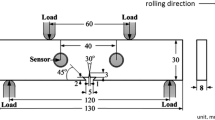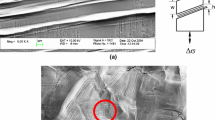Abstract
Alloy grain size is known to influence both the propagation path and the closure stress of surface fatigue cracks in many alloys. The general trend is for the path to be more tortuous and the closure stress to be larger, the larger the grain size. By use of Ti Al-4V and Al 7075-T6, the effects of grain size on the nondestructive detection of surface cracks which might arise from closure stress and path irregularity variables were evaluated. Titanium specimens were inspected using an acoustic harmonic generation technique, and it was discovered that the major source of harmonic signals was grain sized crystallographic cracks. Harmonic signals were larger during fatigue in an 8-µm compared to a 4-µm grain sized alloy, as there were more grain sized cracks in the large grain material. Crack closure was found to be extremely important in determining the reflected acoustic amplitude obtained in inspecting small (100–1000 µm) cracks in Al 7075-T6 using a critical angle technique. Average received amplitudes were an order of magnitude smaller for cracks at zero load than for those opened by a tensile stress. The scatter in the reflected amplitude was also large, apparently as the result of variations in the degree of the closure from crack to crack. For the 7075 material, the important effect of larger grain size was to increase the irregularity of the crack path, making the small cracks more visible acoustically at azimuthal angles not normal to the crack plane.
Similar content being viewed by others
References
O. Buck, C. L. Ho, and H. L. Marcus, Plasticity effects in crack propagation,Eng. Fract. Mech. 5:23 (1973).
O. Buck, J. D. Frandsen, and H. L. Marcus, Crack tip closure and environmental crack propagation,Eng. Fract. Mech. 7:167 (1975).
W. L. MOrris, M. R. James, and O. Buck, Growth rate models for short surface cracks in Al 2219–7851,Met. Trans. 12A:57 (1981).
W. L. Morris and M. R. James, On the applicability of fracture mechanics to short crack propagation during fatigue, inReview of Progress in Quantitative NDE, Vol. 1, D. O. Thompson and D. E. Chimeti, eds. (Plenum Press, New York, 1982), p. 329.
M. R. James and W. L. Morris, Effect of fracture surface roughness on growth of short fatigue cracks,Met. Trans. 14A:153 (1983).
W. L. Morris, M. R. James, and O. Buck, A simple model of stress intensity range threshold and crack closure stress,Eng. Fract. Mech. 18:871 (1983).
W. L. Morris, The noncontinuum crack tip deformation behavior of surface microcracks,Met. Trans. 11A:1117 (1980).
A. K. Zurek, M. R. James, and W. L. Morris, The effect of grain size on fatigue growth of short cracks,Met. Trans. 14A:1697 (1983).
M. R. James and J. B. Cohen, The measurement of residual stresses by X-ray diffraction techniques, inTreatise on Materials Science and Technology, Vol. 19A, H. Hermon, ed., (Academic Press, New York, 1980), pp. 1–62.
M. A. Breazeale and D. O. Thompson, Finite amplitude ultrasonic waves in aluminum,Appl. Phys. Lett. 3:77 (1963).
A. Hikata, B. Chick, and C. Elbaum, Dislocation contribution to the second harmonic generation of ultrasonic waves,J. Appl. Phys. 36:229 (1965).
O. Buck, W. L. Morris, and M. R. James, Remaining life prediction in the microcrack initiation regime, inFracture and Failure: Analyses, Mechanisms and Applications, P. P. Tung, ed. (ASM, Metals Park, Ohio, 1981), pp. 55–64.
W. L. Morris, R. V. Inman, and W. J. Pardee, Acoustic harmonic generation for remaining fatigue lifetime estimation in Ti-6Al-4V alloy, inNovel NDE Methods for Materials, B. B. Rath, ed., AIME Annual Meeting, Dallas, Texas. February 1982, (AIME, Warrendale, Pennsylvania, 1983), pp. 119–130.
Author information
Authors and Affiliations
Rights and permissions
About this article
Cite this article
Morris, W.L., Richards-Frandsen, R.J., Elsley, R.K. et al. Relationships between crack opening displacement, alloy variables, and crack detection sensitivity. J Nondestruct Eval 3, 189–200 (1982). https://doi.org/10.1007/BF00565864
Received:
Revised:
Issue Date:
DOI: https://doi.org/10.1007/BF00565864




